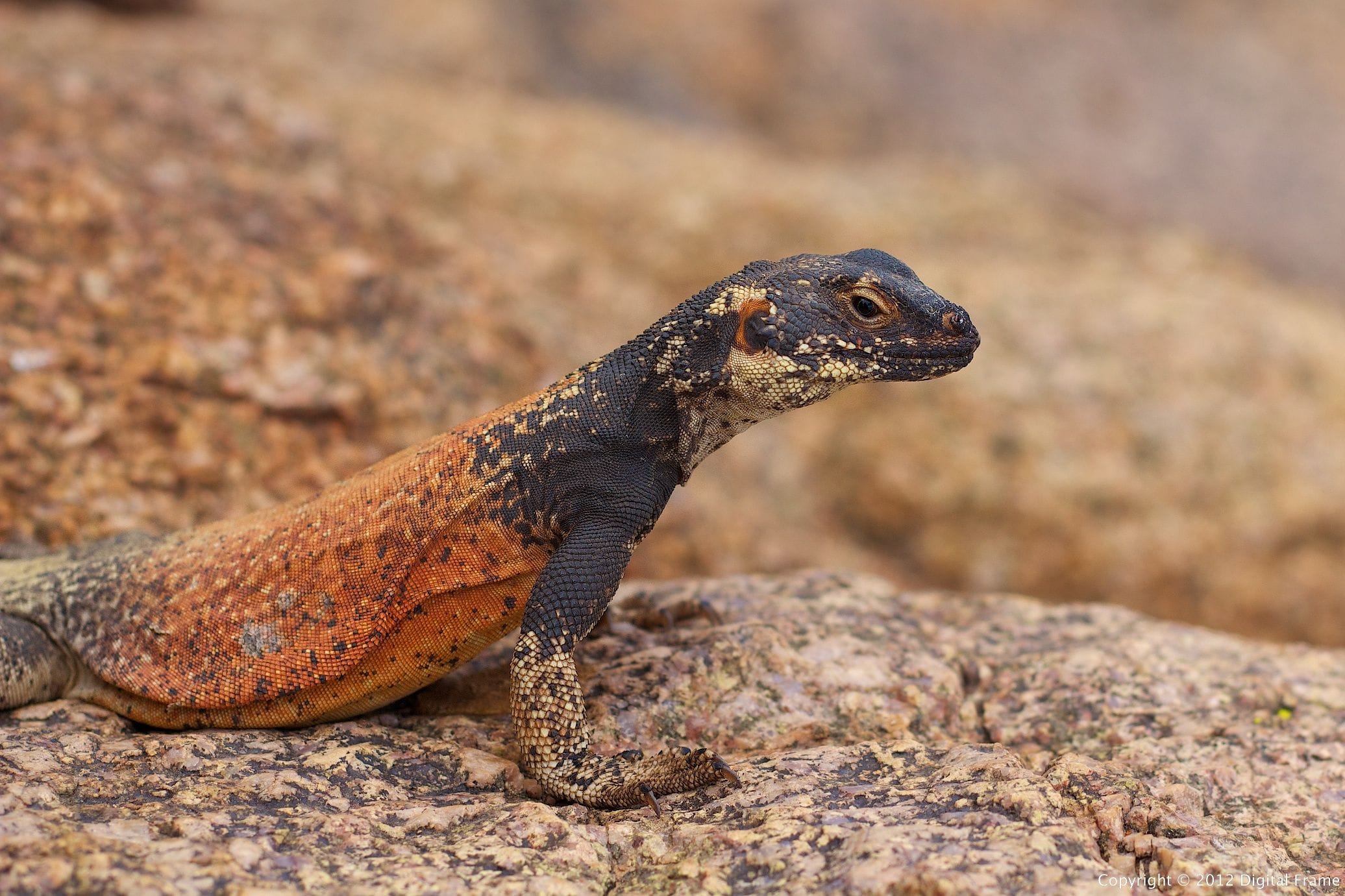Unveiling the Chuckwalla: A “Mini-Tank” of the Desert
Chuckwallas, often called “mini-tank” lizards, reign supreme in the deserts of the southwestern US and parts of Mexico. These remarkable reptiles exhibit incredible adaptations for desert survival. Their tough, scaly skin provides excellent camouflage against the rocky backdrop, and their size varies from a respectable 10 to 20 inches, with variations in size and color depending on the specific type of chuckwalla.
These masters of camouflage prefer rocky terrains, especially those with crevices and boulders offering shelter from predators and the scorching desert sun. You’ll most likely encounter them in the Sonoran and Mojave Deserts.
The Vegetarian Lizard: Busting Myths About the Chuckwalla’s Diet
Despite their rugged appearance, chuckwallas are primarily herbivores, feasting on a variety of desert plants. Their diet consists mainly of leaves, flowers, and fruits, and remarkably, they obtain most of their water from these plants, showcasing their incredible efficiency in a water-scarce environment.
These diurnal reptiles are most active during the day, preferring a solitary existence except during mating season. Impressively, chuckwallas can live for 25 years or more in captivity, with lifespans in the wild likely even longer, making them a testament to nature’s resilience.
Challenges in a Changing World: Protecting the Chuckwalla and its Habitat
Sadly, like many species, chuckwallas face growing threats. Habitat loss due to urbanization and agriculture expansion, coupled with the introduction of invasive species like fire ants, pose significant challenges to their survival. Protecting their fragile desert ecosystems is crucial, not only for chuckwallas but for the delicate balance of these unique environments.
Chuckwallas as Companions: Are They the Right Fit for You?
The idea of sharing your life with a chuckwalla might seem enticing, and while they can make fascinating companions, they are not your average pet lizard. Their specific needs and long lifespan require a dedicated owner who understands the responsibility involved.
Here’s what you need to know before welcoming a chuckwalla into your home:
Setting the Stage: Replicating the Desert Oasis
- Spacious Enclosures: Chuckwallas are active explorers, and a spacious enclosure is paramount. Aim for a minimum size of 4 feet long, 2 feet deep, and 2 feet high, but remember, bigger is always better! Providing ample space for climbing, basking, and exploring is essential.
- Temperature Control: Replicating the desert climate is key. A temperature gradient is crucial, with a basking spot reaching 100-110°F and a cooler area on the opposite side of the enclosure.
- UVB Lighting: This specialized lighting is non-negotiable. It enables chuckwallas to produce vitamin D3, which is vital for calcium absorption and maintaining healthy bones.
- Natural Substrate: Opt for natural substrates like a mixture of sand and soil, as they closely resemble their natural environment. Avoid materials like wood chips or gravel, which can cause health issues if ingested.
- Safe Havens: Just like us, chuckwallas need their space. Providing them with multiple hiding spots within their enclosure helps reduce stress and offers a sense of security.
The Chuckwalla Menu: A Culinary Journey Through the Desert
- A Plant-Based Diet: As dedicated herbivores, their diet primarily consists of various leafy greens like collard, dandelion, and mustard greens, supplemented with a variety of fresh vegetables.
- Occasional Treats: While fruits can be offered as a treat, it’s essential to keep them in moderation.
- Expert Nutrition: Consulting a reptile veterinarian is crucial for developing a species-specific diet plan that ensures your chuckwalla receives all the necessary nutrients.
- Supplementation: Calcium and vitamin D3 supplements are essential, particularly for young, growing chuckwallas, as they help prevent metabolic bone disease, a common health concern in reptiles.
Maintaining Well-being: A Proactive Approach to Health
- Finding a Reptile Vet: It’s crucial to establish a relationship with a veterinarian experienced in treating reptiles, especially chuckwallas.
- Regular Checkups: Schedule annual checkups to monitor your chuckwalla’s health proactively and address any potential issues early on.
Welcoming a Chuckwalla Home: Choosing Responsibly
- Captive-Bred Over Wild-Caught: Always choose a captive-bred chuckwalla from a reputable breeder. This ensures they are healthy, well-socialized, and accustomed to human interaction.
- Supporting Ethical Breeding: Take the time to research potential breeders and make sure they prioritize animal welfare and ethical breeding practices.
Making the Decision: A Long-Term Commitment
So, can chuckwallas be pets? The answer is a qualified “yes.” While they can bring joy and fascination into your life, their specialized needs make them better suited for experienced reptile keepers. If you’re up for the challenge, have the time, resources, and dedication to provide a stimulating and enriching environment, a chuckwalla might be the perfect companion for you.
Are Chuckwallas Good for Beginners?
While their unique appearance and seemingly docile nature might be alluring to first-time reptile owners, chuckwallas are not generally recommended for beginners. Their specific care requirements, potential for skittishness, and exceptionally long lifespan (up to 25 years in captivity) require experience and dedication.
Here’s why chuckwallas might not be the best fit for beginners:
- Specialized Care: Chuckwallas have very specific needs regarding their environment, diet, and handling. Their desert-dwelling nature necessitates careful temperature and humidity control, a specialized herbivorous diet, and a spacious enclosure to accommodate their active nature.
- Long-Term Commitment: Their impressive lifespan of 25+ years requires a significant commitment. It’s crucial to consider whether you can provide consistent care for such an extended period.
- Potential for Skittishness: While captive-bred chuckwallas are generally calmer than their wild counterparts, they can still be skittish, especially if not handled regularly from a young age. This can make bonding and interaction more challenging for novice owners.
Captive-Bred vs. Wild-Caught: Making the Responsible Choice
If you’re set on getting a chuckwalla, always choose a captive-bred individual from a reputable breeder. Here’s why:
- Health and Well-being: Captive-bred chuckwallas are less likely to carry parasites or diseases and are typically healthier overall due to controlled breeding environments and regular veterinary care.
- Temperament: They are generally calmer and more accustomed to human interaction, making them better suited for life in captivity.
- Ethical Considerations: Choosing a captive-bred chuckwalla supports ethical breeding practices and helps reduce the demand for wild-caught individuals, which often suffer from stress, injury, or improper care during capture and transportation.
Finding the Right Reptile Companion
Chuckwallas are undoubtedly fascinating creatures, but their specific needs make them better suited for experienced reptile enthusiasts. If you’re new to reptile keeping, several other fantastic options might be a better fit for your lifestyle and experience level.
Before bringing any reptile home, thorough research is essential. Consider factors like your experience level, available space, time commitment, and resources to ensure you can provide a safe, enriching, and fulfilling life for your chosen companion.
Do you wish to extend your beloved tortoise’s average lifespan? Learn more about how to do so by clicking here.
How Big of a Tank Does a Chuckwalla Need?
Providing a spacious and stimulating environment is crucial for a chuckwalla’s well-being, and the size of their enclosure plays a significant role in their overall health and longevity. While the absolute minimum tank size for a single adult chuckwalla is 4 feet long, 2 feet deep, and 2 feet high, it’s essential to understand that this is the bare minimum and larger enclosures are always recommended.
Think of it this way: providing ample space is not just about preventing overcrowding; it’s about replicating essential aspects of their natural habitat and allowing them to engage in natural behaviors.
Here’s why tank size matters for chuckwallas:
- Thermoregulation: As desert dwellers, chuckwallas rely on a temperature gradient within their environment to regulate their body temperature. They need a hot basking spot to warm up and a cooler area to retreat to when needed. A larger enclosure provides more space to establish this gradient effectively.
- Exercise and Enrichment: Despite their stocky build, chuckwallas are surprisingly agile climbers and explorers. A spacious enclosure encourages physical activity, which is essential for maintaining a healthy weight and preventing obesity, a common issue in captive reptiles.
- Behavioral Enrichment: In the wild, chuckwallas spend a significant amount of time exploring, foraging, and seeking out shelter. A larger enclosure allows for more complex and stimulating environments, mimicking their natural habitat and reducing stress. Providing space for hides, climbing structures, and even shallow digging areas can significantly enhance their well-being.
Material Considerations
- Wood: Many experienced chuckwalla keepers prefer wooden enclosures due to their superior insulation properties. Wood helps maintain more stable temperatures, which is crucial for these desert reptiles.
- Glass: While glass enclosures are aesthetically pleasing, they are not ideal for chuckwallas as they don’t retain heat well. If you choose a glass enclosure, be prepared for more frequent temperature fluctuations and potentially higher heating costs.
Planning for the Future
When choosing an enclosure size, always plan for your chuckwalla’s adult size, not their size as a juvenile. Juveniles can start in smaller enclosures, but they will outgrow them quickly, necessitating an upgrade.
Do you want to know why a chuckwalla lizard is a good pet for beginners? Click here to find out more.
This revised and expanded article aims to provide comprehensive information on chuckwalla reptiles, their care requirements, and their suitability as pets, incorporating the requested details, internal links, and a more engaging tone.












